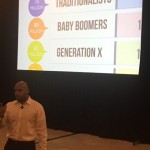Bryan Lansing, generational expert and keynote speaker from BridgeWorks, LLC, wore his title well in kicking off the first of 10 solid education sessions at IAVM’s GuestX program that wrapped up Thursday with attendees taking a tour of The Ford Center at the Star in Frisco, the training camp home to the Dallas Cowboys.
Lansing, a Millennial (the age group born between 1980-1995), admitted that in a text communication with a fellow M he was taken aback at his friend’s response.
“I had said that I was looking forward to seeing him soon and ended it with an exclamation point,” Lansing said. “He  replied, OK, with a period at the end. A period at the end? Did I do or say something wrong? Did I offend him?”
replied, OK, with a period at the end. A period at the end? Did I do or say something wrong? Did I offend him?”
While the crowd chuckled, it was but one most fitting example of how generations communicate in today’s high-tech, phone-handy society and how that communication is interpreted.
Lansing spent an informative hour talking about the various generations that are not only in today’s workplace, but the same generations that are patrons of public assembly venues.
“Why do Baby Boomers (born between 1946-1964) want to meet?” he asked. “Why do Millennials always happen to be on their cell phones? I mean, you are talking to someone outside your generation and you are both speaking English, but feel you are speaking different languages.”
Lansing gave a vivid example of how two generations can view the same word from a different perspective. He asked a Baby Boomer what the person thought of when the word “NASA” was spoken. The response was about the United States landing a man on the moon on July 20, 1969. Lansing asked a Millennial what came to mind with the same word. The response, appropriately, was the Space Shuttle Challenger disaster. One word, two meanings.
“We can get frustrated working with people outside our generation,” he said. “My goal is to help you connect, communicate and understand generations outside your own.”
In addition to the two aforementioned groups, others include Traditionalists (born before 1946), Generation X (born between 1965-1979) and Generation Z (born after 1996 and ongoing).
To understand a Traditionalist is to understand someone who came up through the Depression and was often without a job. This is the group that coined “waste not, want not.” After fighting through two World Wars, this is a class that brought a militaristic mindset to the table. Patriotism, work ethic, a fiscal conservatism and faith in institutions are also byproducts of Traditionalists.
“Once these people returned from fighting, you saw babies being born like crazy,” Lansing said. “That is how we got Baby Boomers, a group that has 10,000 a day turning 65.”
Civil rights came into play as this class believed it could make a change. The group arrived early to work, stayed late and put in anywhere from 60 to 80 hours a week on the job. It is an optimistic, idealistic class that questions authority and is competitive.
Lansing noted the advent of video games to help define those in Generation X. By the time this group reached its teen years, those three or four basic television channels now burst with 145 channels or more. Another cable phenomenon was when CNN introduced 24-hour news.
“Xer’s grew up seeing the veil pulled back,” Lansing said. “We saw OJ being chased in the Ford Bronco, the Exxon Valdez oil spill. This became a group that said, ‘We can’t trust anybody.’ It became a group that was independent, resourceful, entrepreneurial, skeptical and said that work and life must balance.”
While Millennials were born when the early Macintosh computers performed at 128 kilobytes, that number amazingly equates to two tweets today.
“Millennials have had massive change in a short time,” he said. “We want updates faster. Social media is the thing. We grew up with the ability to connect with people halfway around the world. And the group has experienced violence right here at home. During 9/11 we were kids and teenagers. If anything this has made the group comfortable talking about anything. It is a diverse, collaborative, socially accepting and tech-comfortable class.”
Lansing said the three areas to manage for cross-generational success include leadership, such as providing opportunities for the different groups to share their voice. “Let Millennials sit in with the top-level management at meetings,” he said.
Another aspect is to keep the management authentic. “Ask them about their day, how they are doing,” Lansing said. “Be that leader who people will follow whether you have a title or not.”
Finally, communicate the why. “Few people can talk about why they do what they do,” he said. “Every organization is better when they understand who the generations are. Communicate the why.”
